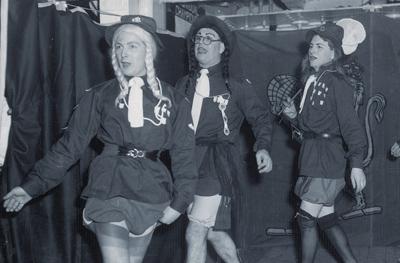Gay men wandering Halifax’s dockyards in the 1950s likely heard the pickup line, “Hello sailor!” Now, the cheeky line is the name of an exhibition celebrating the history of gay seafarers from the 1950s until present day. In its first Canadian showing, Hello Sailor!: Gay Life on the Open Wave opened at Halifax’s Maritime Museum of the Atlantic on May 19.
Historian Jo Stanley says she was astonished to learn about the role of gay men in maritime history.
“It’s an extraordinary subculture,” she says. “I had no idea that the macho, even misogynist world of the merchant navy… was so attractive and supportive and taken over by gay men.”
Stanley has been studying gay sailors since 2002 and has co-authored a book called Hello Sailor!: The Hidden History of Gay Life at Sea. She curated the original museum exhibit for Merseyside Maritime Museum in Liverpool, England.
At a time when homosexuality was illegal in the United Kingdom, merchant ships were refuges for gays. Before ocean liners had on-board entertainers, flamboyant ship stewards entertained guests with cabaret acts and drag shows. The uniqueness of life at sea allowed gay life to flourish. While homophobia existed on ships, it was not as rampant as it was on land.
“Something happens when ships are at sea…. [people] become much more tolerant in exceptional situations,” Stanley says. “Normal values don’t operate in the same strict way.”
Gay men were not the only ones to find love and adventure while working on ships. Lesbians, bisexuals and trans people also enjoyed life below the decks. Bisexual men might have a relationship with a man at sea but a wife and family at home. Before sexual reassignment surgeries were readily available, seafaring trans men could buy hormone pills overseas that were not legal in the United Kingdom.
Since the exhibit was launched in 2006, curator Dan Conlin has been trying to bring the exhibit to Halifax. As Canada’s maritime hub, Halifax is a logical host for he says.
“[The] big British ocean liners [that] created this really rich, large, interesting gay subculture came to Halifax all the time in the ’50s and ’60s,” he says.
To complement Stanley’s original research about British sailors, the Maritime Museum of the Atlantic wanted to add a Canadian perspective. After launching an oral-history project, five former sailors volunteered to share their stories. Other documentation about gay sailors is scarce.
“LGBTI mariners don’t appear on the written record that much, and when they do, it’s unpleasant things like people getting kicked out of the navy,” says Conlin.
One of the exhibit’s shortcomings is a lack of artifacts. Conlin explains that the nomadic nature of mariners’ lives means not many personal items have been preserved.
“[Sailors] don’t tend to keep a lot of objects that are highly symbolic,” he says. “There is not a ton of material that displays, in a three-dimensional sense, the life of a gay or lesbian mariner.”
While the artifacts are not numerous, they are memorable. The full-scale re-creation of a steward’s cabin comes complete with colourful boas and a bedside picture of Paul Newman.
Another highlight is the sequin-studded drag costumes altered from traditional naval uniforms. The costumes belong to Chris Cochrane, a former sailor who now performs as one of Halifax’s most famous queens, Elle Noir. For Conlin, the costumes represent the best of the exhibit.
“[The costumes] really speak quite powerfully about challenging your assumptions about people in the Navy,” he says.
Hello Sailor! is showing at the Maritime Museum of the Atlantic until Nov 27.

 Why you can trust Xtra
Why you can trust Xtra


